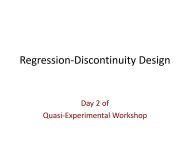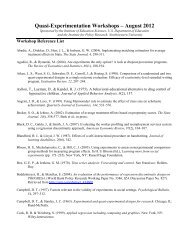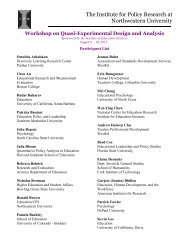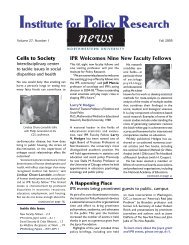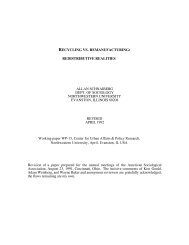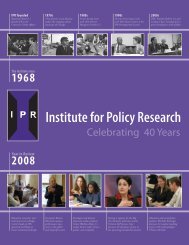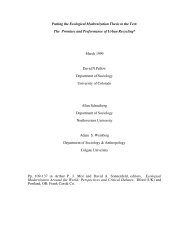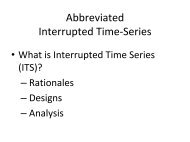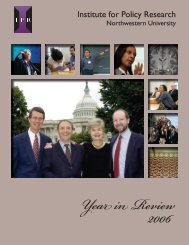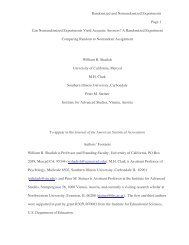Download working paper PDF - Institute for Policy Research ...
Download working paper PDF - Institute for Policy Research ...
Download working paper PDF - Institute for Policy Research ...
You also want an ePaper? Increase the reach of your titles
YUMPU automatically turns print PDFs into web optimized ePapers that Google loves.
Table 6. Claim Duration<br />
Duration<br />
Injury to Close<br />
Claim Opening to Close<br />
Mean Median Mean Median<br />
Adult Non-elderly (19-64) 3.98 3.63 2.55 2.22<br />
Elderly (65+) 3.47 3.33 2.30 2.04<br />
Adult Non-elderly - Elderly 0.50 0.30 0.26 0.18<br />
t-stat <strong>for</strong> mean or χ 2 (p-value)<br />
61.81<br />
27.75<br />
11.37***<br />
7.54***<br />
<strong>for</strong> median<br />
(0.000)***<br />
(0.000)***<br />
Mean and median claim duration in years <strong>for</strong> 12,108 nonduplicate, non-nursing-home, med mal cases closed<br />
from 1988-2007 with payout > $25,000 in 1988 dollars. Last row reports t-statistics <strong>for</strong> difference in means,<br />
and χ 2 <strong>for</strong> difference in medians (p-value in parentheses) *, **, *** indicate significance at the 10%, 5%, and<br />
1% levels respectively. Significant results (at 5% level) are in boldface.<br />
We also analyzed non-parametric Kaplan-Meier survival curves <strong>for</strong> the period from<br />
injury to close, using cases that settled be<strong>for</strong>e trial completion. The elderly claim survival<br />
curve was consistently below the non-elderly curve. 41 For example, four years after injury,<br />
70% of claims by the elderly are settled, compared to 58% of claims by the non-elderly. In<br />
unreported regressions, we confirm that elderly claims close faster over the full sample<br />
period, but also find evidence of convergence: the duration of elderly claims increases by<br />
around 1.1% per year; there is no similar trend <strong>for</strong> non-elderly claims.<br />
In unreported regressions, we find that duration drops post-re<strong>for</strong>m by about 44%,<br />
<strong>for</strong> elderly plaintiffs and about 32% <strong>for</strong> adult non-elderly plaintiffs. This difference in<br />
re<strong>for</strong>m effects is also statistically significant. The reasons <strong>for</strong> this drop are not clear. One<br />
speculation: Post-re<strong>for</strong>m, plaintiffs’ lawyers are more likely to avoid complex cases, so<br />
the cases they bring close faster. Alternatively, if tort re<strong>for</strong>m encourages plaintiff’s<br />
lawyers to drop weaker cases (by making them less remunerative), the remaining “strong”<br />
cases may settle more quickly. We are unable to evaluate these explanations with our data.<br />
F. Stage of Resolution<br />
The elderly are more likely than the adult non-elderly to resolve a large paid claim<br />
without a lawsuit, and less likely to take a case to trial. Within the elderly, the likelihood<br />
of resolution without a lawsuit rises with age. Table 7 provides summary statistics.<br />
41 A log-rank test strongly rejects the null of equal survival functions (χ 2 = 291, p = 0.0000).<br />
18



